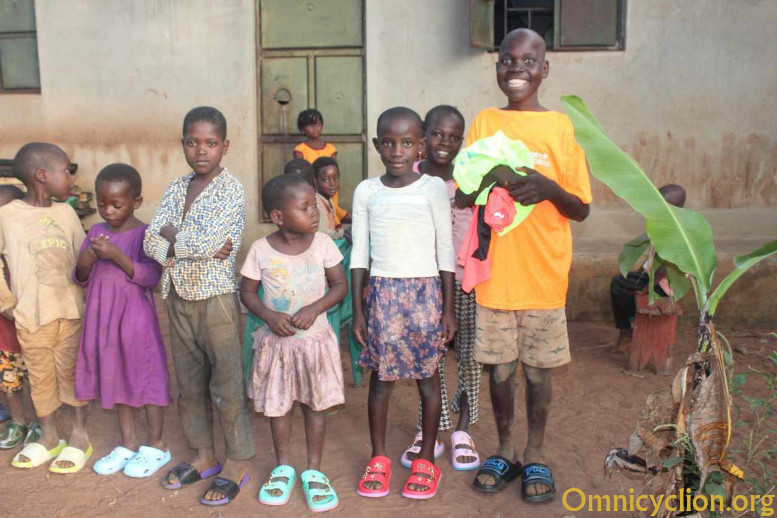AFRICAN SUNLIGHT TO STERILIZE OBJECTS AND DRINKING WATER IN EMERGENCIES

– Cranimer (11) of One Home Charity Mission particularly enjoying his new shirt and sandals!
Solar Sterilization: Harnessing Africa’s Sunlight to Disinfect Water, Clothes, and Surfaces
In many parts of Africa, infectious diseases such as Mpox, cholera, typhoid, and HIV (outside the body) pose serious public health risks, particularly in orphanages and community centers where access to medical supplies and sanitation facilities may be limited. Fortunately, solar ultraviolet (UV) radiation provides a natural, cost-free method for disinfecting contaminated materials, reducing the spread of infections. This article explores the effectiveness of sunlight in killing harmful pathogens and provides precise exposure times for different UV-intensity regions of Africa.
How Solar UV Radiation Disinfects Objects and Water
Ultraviolet light, particularly UV-C and high-intensity UV-B, has strong germicidal properties. These UV rays break down DNA and RNA in bacteria, viruses, and fungi, rendering them inactive and unable to reproduce. In high-UV environments, solar exposure can eliminate many pathogens in just a few hours, offering a simple and effective way to sterilize common household and community-use items.
Pathogens That Can Be Eliminated by Sunlight
Sunlight exposure can effectively kill or deactivate a range of pathogens, including:
- Bacterial Infections: Escherichia coli (E. coli), Salmonella, Vibrio cholerae (cholera), and Mycobacterium tuberculosis (TB bacteria on surfaces)
- Viral Infections: Mpox, Hepatitis A, Hepatitis E, Rotavirus, Norovirus, Poliovirus, and HIV (outside the body)
- Fungal Infections: Dermatophytes and Candida species (common skin infections)
- Parasitic Organisms: Certain protozoa and helminths (if exposed long enough)
Disinfecting Mattresses, Clothes, and Household Items
For objects that cannot be washed easily, such as mattresses, clothing, and wooden surfaces, sunlight exposure offers a powerful way to reduce microbial contamination. The recommended exposure times depend on regional UV intensity:
- High-UV Regions (Sahara Desert, Ethiopian Highlands, Sahel Zone) – 3-4 hours of full sun exposure can quasi-sterilize most surfaces.
- Moderate-UV Regions (Uganda, Kenya, Nigeria, Central Africa) – 6 hours of exposure is required for significant sterilization.
- Low-UV Regions (Coastal South Africa, Mountainous Areas in Winter) – 12-16 hours of exposure may be necessary for equivalent disinfection.
To ensure maximum effectiveness:
- Lay objects flat with maximum exposure to direct sunlight.
- Flip and rotate items midway through exposure for uniform UV treatment.
- Avoid excessive shading, as indirect light is far less effective.
Solar Water Disinfection (SODIS)
For communities relying on untreated water sources, the SODIS (Solar Disinfection) method is a life-saving technique that uses solar UV radiation to purify drinking water. The process is simple:
- Fill clear plastic (PET) bottles with contaminated water. Ensure there are no visible particles; filter if necessary.
- Place bottles in direct sunlight. The duration depends on regional UV intensity:
- High-UV Regions: 3-4 hours for effective sterilization.
- Moderate-UV Regions: 6-8 hours for full disinfection.
- Low-UV Regions: 16+ hours, possibly requiring two full sunny days.
- Shake bottles before exposure. Oxygenation enhances bacterial kill rates.
- Drink directly from the bottle or store in clean containers.
This method effectively neutralizes bacteria, viruses, and parasites like Giardia and Cryptosporidium, making water safer for orphanages and communities with limited access to clean drinking water.
Limitations and Considerations
While solar sterilization is highly effective for many pathogens, there are a few considerations:
- Cloud cover and pollution reduce UV intensity, requiring longer exposure times.
- Some parasitic cysts and spores (e.g., Clostridium difficile spores) are more UV-resistant and may need additional treatment.
- Dark-colored materials heat up quickly, aiding in bacterial death but potentially damaging fabrics and plastics.
- HIV does not survive well outside the body, and while UV radiation can destroy viral particles on surfaces, it does not cure infected individuals.
Conclusion: A Simple Yet Powerful Solution
Harnessing the African sun to disinfect water, clothes, and household items is a cost-free, highly effective strategy for reducing infections, particularly in orphanages and underserved communities. By following proper exposure times and techniques, communities can dramatically lower the risk of disease transmission, improving overall health and safety.
This method aligns with Omnicyclion’s philosophy of using accessible, nature-based solutions to promote health, resilience, and collective well-being. The power of the sun is free—let’s use it to protect the most vulnerable.